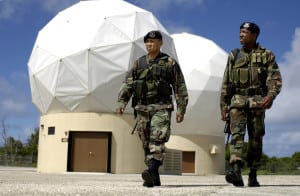Latest News

Andersen Air Force Base, Guam, satellite tracking station. Photo: U.S. Air Force/Tech. Sgt. Shane A. Cuomo
[Via Satellite 09-14-2015] The U.S. military is preparing to shift away from having multiple independent ground systems in favor of one unified system for its satellite networks. This effort, known as the Enterprise Ground System (EGS), aims to modernize the ground segment for military users, expunging integration and scalability challenges by introducing a more effective system with greater cost efficiencies.
“Our space ground enterprise was designed in a different era for a different time. This is an architecture that must be secure, it must be agile and it must be cost effective,” Lt. Gen David Buck, United States Air Force commander, 14th Air Force and Joint Forces Component Commander (JFCC) for Space, said Sept. 11 during a Mitchell Institute event in Washington, D.C.
Buck said the problem with having multiple siloed ground systems, commonly referred to as “stove-piped,” is that it inhibits security, resiliency, agility and affordability. Today ground systems for different satellites are segmented by mission area, and require individualized operating systems each functioning with unique proprietary software from contractors. The Department of Defense (DOD) does not own this software, without which, Buck said the government cannot sufficiently manage the interface. Furthermore, upgrades and new releases require data and expertise from the original contractor. Buck said that with EGS, there will be competition for initial fielding, but contractors will no longer own the baseline in order to enable competition for subsequent iterations.
“The government must own the technical baseline … we must control the interfaces and standards. We can’t be cornered by proprietary software that limits our ability to interface,” he said, adding that, “At the most basic level, no single contractor should have control over the architecture.”
Buck listed the program’s four primary goals as improving agility, automation, security and resilience. Cost savings would be an inherent result, he said. The U.S. Air Force is studying multiple pathfinder projects across areas including Telemetry, Tracking and Control (TT&C), data distribution, and Command and Control (C2). Several directorates in Air Force’s Space and Missile Systems Center (SMC) have already started working on these initiatives.
“[SMC’s] Advanced Systems [Directorate] is working in the area of automated TT&C, and leading the EGS initiative. Remote Sensing is exploring the exploitation of payload data, and the Space Superiority Directorate is looking at the integration of warfighter capability into [the Joint Space Operations Center (JSpOC) Mission System (JMS)]. The goal is to deliver these capabilities before existing systems recapitalize their stove-piped systems,” said Buck. He said the 14th Air Force JFCC is experimenting with limited automation on the Operationally Responsive Space 1 (ORS 1) satellite. DOD desires to leave rote tasks such as satellite bus management to machines, freeing up manpower to handle other tasks.
EGS should also bring many benefits from a cybersecurity stance. Buck said the current architecture used for military satellites has too many interfaces with incongruous software, creating multiple cyber attack surfaces that must be defended individually. The improved system would have secured information enclaves, layered defenses, minimized privileges, segmentation, built-in monitoring devices, and redundancy, he said. Buck would not worry about hackers gaining access to multiple satellite systems through EGS, he added.
DOD is interested in using cloud technology for EGS. Buck said the decision needs to be made on what type of cloud, and that the Air Force is leaning toward a private cloud, which would physically reside at the location of space operations centers. An enterprise cloud would be offsite and connected by fiber or other means, which poses a risk in conflict.
EGS is still in the formative stages today. Buck said the early program will be domestic and that it is too far out to consider international collaboration. He emphasized using Commercial Off the Shelf (COTS) products as a way to reduce costs, and described finding the right capitalization point as the biggest challenge at this stage.
Get the latest Via Satellite news!
Subscribe Now